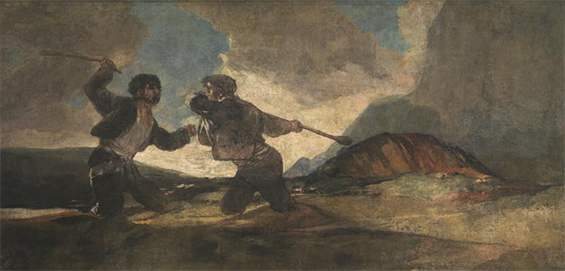Las Pinturas Negras
Las Pinturas Negras (Black Paintings), Francisco Goya's most chilling and famous paintings, were actually never intended to be seen by anyone but the painter himself.
A decade after the Napoleonic Wars, having completely lost his hearing, an embittered Goya moved into a house on the outskirts of Madrid known as the 'Quinta del Sordo' (Deaf Man's Villa) as the previous owner was also deaf. There, in his isolation Goya began to express his internal turmoil by painting directly on the walls of the house with oil paints.
Las Pinturas Negras were never named or given any kind of explanation by the artist. Since they were found and mounted on canvas for display in Madrid's Museo del Prado, art historians gave the 14 paintings this collective name, as well as naming each individual picture. This certainly helps with identifying them but it is important to remember when we study las Pinturas Negras that this may not be what the artist had intended, and the name of each painting may not truly decipher what is depicted.
The collection of 14 somewhat pessimistic pieces of art are united by a similar colour scheme running throughout. Practically all the paintings contain a mixture of black and different shades of brown illuminated by a dirty ocre yellow which adds dim light to the scenes to highlight certain elements. A couple of the paintings break with this pattern with splashes of red, blue or stark white.

Some of the better known Pinturas Negras denote a vicious and violent tone like that of 'Saturn devouring his Son' or 'Duel with Cudgels' and many people assume that the entire series follows this theme. However, some of the images depict unexplained, nightmarish scenes, like 'Perro Semihundido' and 'The Great He-Goat' or purely melancholic studies of people like the gentle mourning figure in 'Leocadia' or the characterful faces in 'Old man and old woman eating soup'.
These lesser known but equally spectacular paintings prove that Goya's Pinturas Negras stemmed from a lot more than just anger. His internal anger is easier to identify when we examine Saturn tearing the arm off his son, but the other paintings add a further dimension to Goya, allowing us to see that his mental state was a lot more complex. If we study the faces of the people, many of them grotesque and witch-like in their expressions, we find that Goya went way beyond rage and his deafness allowed him to delve right into the souls of people, displaying on the outside what human nature so carefully tries to guard on the inside.
Many of Goya's Pinturas Negras have become iconic in both the art world and within contemporary Spanish culture. Most notably, 'Duel with Cudgels' has come to represent a premonition of the struggle between Old and New Spain. Bigas Luna recreates the picture in the closing scene of his 1992 film, Jamón Jamón. Replacing the cudgels with legs of ham, Luna uses Goya's famous imagery to highlight the danger of selling out to modernisation (see Spanish Movies for more information).
Las Pinturas Negras are hung in the Prado Museum in Madrid and consist of the following paintings:
- A Pilgrimage to San Isidro
- Saturn devouring his Son
- Two Monks
- The Great He-Goat (or Witches Sabbath)
- Leocadia
- Duel with Cudgels
- Perro Semihundido (or The Dog)
- Judith and Holofernes
- Old Man and Old Woman eating soup
- Reading
- A Man and Two Women Laughing
- The Fates
- Procession of the Holy Office
- Asmodea


